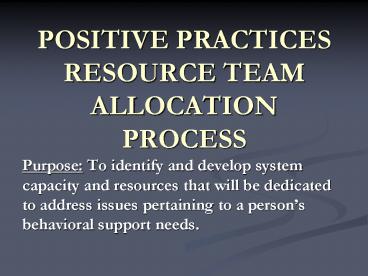POSITIVE PRACTICES RESOURCE TEAM ALLOCATION PROCESS - PowerPoint PPT Presentation
1 / 20
Title:
POSITIVE PRACTICES RESOURCE TEAM ALLOCATION PROCESS
Description:
POSITIVE PRACTICES RESOURCE TEAM ALLOCATION PROCESS Purpose: To identify and develop system capacity and resources that will be dedicated to address issues pertaining ... – PowerPoint PPT presentation
Number of Views:71
Avg rating:3.0/5.0
Title: POSITIVE PRACTICES RESOURCE TEAM ALLOCATION PROCESS
1
POSITIVE PRACTICES RESOURCE TEAMALLOCATION
PROCESS
- Purpose To identify and develop system capacity
and resources that will be dedicated to address
issues pertaining to a persons behavioral
support needs.
2
STARTLING STATISTIC!!
- 20-35 of all people with mental retardation
- have a psychiatric disorder - compared to
- 16-20 among the general population.
3
The National Institute of Mental Health (NIMH)
- mental health disorders occur substantially
more often in person with mental retardation than
they do in population without mental retardation.
- The full range of psychopathology that exists in
the general population also exists in persons
with mental retardation.
4
Why So Prevalent?
- Negative social conditions throughout life
- Rejection by others/stigmatization and the lack
of acceptance in general - Limited coping skills associated with language
difficulty - Inadequate social supports
- High frequency of central nervous system
impairment
5
IMPACT
- Disrupts family and peer relationships
- Interferes with educational/vocational progress
- Jeopardizes residential placements
- Bottom Line greatly reduces a persons quality
of life - Summation It is imperative that people receive
an accurate diagnosis and appropriate
treatment/supports
6
Criteria For Referral
- A person with a developmental disability who is
demonstrating escalating at-risk behavioral
challenges. - Person the support team determines may be at risk
for needing enhanced levels of support that are
not readily available or known to the team.
7
OMHSAS OMR Collaboration
Recovery Principle Everyday Lives Principle
Principle that guides all interventions/interaction Consumer centered and self determined Driven by the belief that people need to have hope, connectedness, support, knowledge, value, purpose, and meaning in life Principle that guides all supports and services Person centered Driven by the belief that people, with or without a disability, want to be treated with dignity, respect, and have a life that includes choice, control, and relationships
8
Positive Practices Guides for Support
- Environment Recognize that the persons
environment meets their needs and may influence
their behavior. - Communication- Recognize that behavior is an
attempt to communicate and promote assisting
people to find ways to express themselves and be
understood.
9
Guides to Support, contd.
- Assessment - Recognize the need for prompt
assessment, diagnosis, and treatment of a
persons physical and psychiatric needs. - Hanging in There Service and support staff need
to have the ability to hang in there and
continually reevaluate the environment,
communication factors, and reassess needs.
10
System Resources
- Advocacy Staff (PPA ARC etc.)
- Consultant Staff
- County Staff
- Families/Friends
- Health Care Quality Units (HCQU)
- Office of Autism Affairs
- OMR and OMHSAS Staff (Regional Offices State
Hospitals State Centers) - Positive Practices Resource Team (PPRT)
11
POSITIVE PRACTICES RESOURCE TEAM
- PPRT utilizes staff assigned to State Hospitals
and State Centers demographically by region. - Skills and experience of PPRT cover a wide range
in the positive approaches areas - Psychiatrist Psychologist Nurses
Pharmacist Social Worker Direct Support
Service Recreation Therapist Educator/Trainer
Spiritual/Pastoral Support
12
Positive Practices Resources Team (PPRT)
Allocation Process
- The referral for assistance will be made from any
source including - Advocates
- Counties/Administrative Entities
- Families
- OMHSAS Field Offices
- OMR Customer Service Line
- Self-Advocates
- State Hospitals
13
PPRT Process Contd
- The Regional Program Office will forward the
referral form (Resource Allocation Analysis Form)
along with a summary of the persons current
situation to the PPRT Coordinators. OMR Area
Directors will be copied on this referral.
14
PPRT Process Contd
- The PPRT Coordinators will review with OMHSAS
OMR Regional Office leads to determine next
steps. - If a decision is made to meet with the persons
support team the PPRT Coordinators will identify
PPRT members to be assigned. The assignment will
be based on skill/experience strengths and
availability. A team lead will be assigned.
15
PPRT Process Contd
- The PPRT Coordinators will contact the PPRT
members to provide information ad discuss
activities. The PPRT lead will coordinate
actions with the Regional Office. - Information obtained will be shared with PPRT
members and on site visits conducted after
reviewing information and discussing ideas with
the PPRT Coordinators.
16
PPRT Process, contd.
- The PPRT members will explain their role and
acknowledge the efforts of the support team. - The PPRT members will then ask the support team
for an update and begin to collaboratively bring
together suggestions to address the challenges. - The PPRT lead will begin to compile a work plan
identifying actions to be taken, target dates,
and responsible person. - A copy of the work plan will be shared with the
provider, the PPRT Coordinators, and the Regional
Office.
17
PPRT Process Contd
- The Regional Office Risk Management Committee
will review the status of each work plan until a
desired outcome is achieved.
18
PPRT Process Contd
- The PPRT Coordinators or involved Regional
Office Staff will update the PPRT on outstanding
issues during weekly PPRT update calls. - Information tracked by the PPRT Coordinators will
be incorporated into reviews by the Statewide
Positive Practices Committee and OMR and OMHSAS
Program Offices.
19
PPRT Regional Office Perspective
- Number of referrals
- Status of people referred
- Focus from the Region perspective
20
PPRT Leads
- Gretchen Hathaway, OMHSAS
- ghathaway_at_state.pa.us
- 717-772-7526(office) / 717-649-6682(cell)
- Fred Lokuta, OMR flokuta_at_state.pa.us
- 570-443-4244(office) / 570-233-3520(cell)
- Ellen Wagner, OMR elewagner_at_state.pa.us
- 570-372-5659(office) / 570-809-3765(cell)
- PPRT PP 1/10/07































